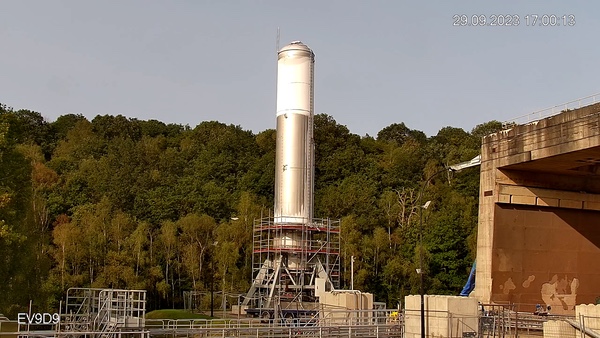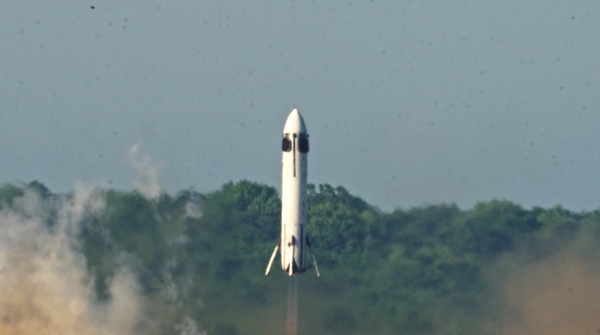A Japanese automaker’s small hop towards reusable rocketsby Jeff Foust
|
| Honda is at least considering getting into the launch business, testing technologies for a future reusable launch vehicle, a sign of how reusable technologies, and mindsets, are proliferating. |
From a technical standpoint, this flight did not break much ground. The DC-X did similar hop tests more than three decades ago, while startups ranging from competitors in the Northrop Grumman Lunar Lander Challenge more than 15 years ago to Chinese companies today seeking to develop reusable launch vehicles have flown similar tests. Blue Origin’s New Shepard booster lands under rocket power after flying above the Kármán Line, while SpaceX’s Falcon 9 booster has done such landings so frequently they have become routine: it’s now rare when such landings don’t happen.
What made this test distinct is that it was not done by a major company in the space industry or a startup or even a government agency. The flight that took place from a test site on the island of Hokkaido in Japan was performed by Honda, a company best known as a car and motorcycle manufacturer. That company is at least considering getting into the launch business, testing technologies for a future reusable launch vehicle, a sign of how reusable technologies, and mindsets, are proliferating.
Elemental research
Honda’s announcement of the June 17 flight took many in the space industry by surprise. The company said in 2021 it was studying reusable rocket technologies but had revealed no details about progress since then until that flight.
Work on reusability started before that, said Keiji Ohtsu, president and representative director of Honda R&D Co., during a talk at the Spacetide conference in Tokyo last week. The project had its origins when a young engineer, whom he did not identify, at the company noted that many of the technologies Honda was working on for automotive applications, from combustion to guidance for autonomous vehicles could be adapted for space.
The project started off in 2019 working on rocket engines, as well as a small vehicle designed to hover just off the ground. That led to the larger vehicle flown last month, 6.3 meters tall and 0.85 meters in diameter, weighing 900 kilograms when empty and 1,312 kilograms when fully fueled.
“The takeoff and landing tests were conducted to verify the elemental technologies described here,” he said in a translation of his Japanese-language remarks provided by conference organizers. That included attitude and guidance systems that allowed the vehicle to land within 37 centimeters of its target on the pad.
While the test was a success, Ohtsu said that Honda had not yet committed to developing a reusable launch vehicle of some kind using that technology. “The takeoff and landing test was successful, but we are still in the elemental research stage,” he said. “Nothing has been decided yet for commercialization.”
He did note that Honda planned to continue testing those technologies, such as a flight to 1,000 meters by 2027 and a full suborbital flight by 2029. He did not disclose how much Honda had spent on the vehicle or the budget for those future tests.
“We believe that rocket research is a meaningful endeavor that leverages Honda’s technological strengths,” Toshihiro Mibe, global CEO of Honda, said in a statement after the flight.
| “The takeoff and landing test was successful, but we are still in the elemental research stage,” Ohtsu said. “Nothing has been decided yet for commercialization.” |
Beyond the fact that Honda believes it has the technologies for a reusable rocket, why is it investing time and money into this project? “By launching satellites using rockets, we can develop connected mobility technologies,” Ohtsu said. “This will lead to values that are highly compatible with Honda.”
He suggested that went beyond traditional applications of satellites, for communications and remote sensing, to future concepts like space-based data centers. “It is expected that data utilization that does not rely on ground-based electricity will progress,” he said. “So, we want to use our technology to enrich the lives of people on Earth from space.”
The reuseable rocket is the most prominent, but not the only, space-related technology that Honda is working on. The company is also developing regenerative fuel cells, with plans to work with Sierra Space and Tec-Masters to test the technology on the International Space Station in 2027. The company is also applying its work on robotics to space, such as humanoid “avatar” robots on the Moon controlled remotely or operating autonomously using artificial intelligence.
 The Themis T1H reusable launch vehicle demonstrator undergoing tests at an ArianeGoup facility in France. The vehicle was shipped last month to Sweden for hop tests. (credit: ArianeGroup) |
Meanwhile, in Europe
Honda’s flight took place while much of the aerospace industry was gathered at the Paris Air Show. Honda itself did not promote the flight at the show, but it was nonetheless discussed privately among attendees.
For some, the flight was evidence that Europe was trailing badly in the race to develop reusable vehicles. It was one thing to be beat by SpaceX or other American companies, or even Chinese companies that are borrowing heavily from the designs of Falcon 9 and Starship for their proposed reusable vehicles. But to have a Japanese automaker fly a reusable vehicle technology demonstrator, developed on its own, was particularly frustrating.
That said, Europe is working on reusable vehicle technologies. That effort includes Prometheus, a methane-fueled engine designed for reuse, and Themis, a vehicle powered by Prometheus that will be used for launch and landing tests. Those efforts are supported by both ESA and the European Commission, the latter through a project with the contrived acronym of SALTO, or reuSable strAtegic space Launcher Technologies & Operations.
During a panel on space transportation at the Paris Air Show June 17, Martin Sion, chief executive of ArianeGroup, the Ariane prime contractor also working on Prometheus and Themis, said that the Themis demonstrator had just been shipped from an ArianeGroup factory in France to the Esrange Space Center in Sweden for its first hop tests. “This is an important part of our reusability roadmap,” he said.
| “This is not about chasing spectacle—it’s about mastering complexity, one carefully crafted demonstrator at a time, on the path from short hops to orbital return,” the SALTO website stated. |
Themis is significantly larger than the Honda vehicle, resembling more closely SpaceX’s Grasshopper vehicle from more than a decade ago used for vertical takeoff and landing tests. ESA devoted an entire article to the overland journey of Themis, 28 meters long and 3.5 meters in diameter, from France to Sweden, taking two weeks to travel more than 3,000 kilometers.
Now at Esrange, workers are preparing the vehicle for tests leading up to a first hop flight to an altitude of about 100 meters. Officials have not discussed detailed scheduled for Themis, but have suggested they would like to conduct the first hop test before the end of the year. There is industry skepticism, though, that Themis will be ready to fly before early 2026, given delays in its development: in 2020, when ESA awarded ArianeGroup a contract for Themis, it was expecting the vehicle to be ready for full suborbital flight tests, not just hop tests, as early as 2023.
Those later suborbital flights would involve a version of Themis designated T3 with multiple Prometheus engines (the version now at Kiruna for the hop tests is known as T1H and has a single engine.) T3 would fly a profile similar to a reusable first stage of an orbital launch vehicle, including both reentry and landing burns before landing at a site downrange of the launch pad.
There is no current schedule for building T3, though. A May article posted on the SALTO website described the vehicle as being still only in the “detailed design” phase, emphasizing the “careful, calculated steps” in the development of reusable vehicles in Europe.
Where that will lead is uncertain. SALTO calls the planned T3 vehicle a “vital bridge” to full-scale orbital launch vehicles with reusable first stages, but the timeline and process for development is unclear.
One obvious beneficiary of the work on Themis is MaiaSpace, the ArianeGroup subsidiary working on a small launch vehicle with a reusable first stage powered by the Prometheus engine. MaiaSpace is working towards a first launch of that vehicle, likely starting with an expendable first stage, as soon as next year.
Others in Europe are working on reusable vehicles. Spanish company PLD Space says it plans to recover and reuse the first stage of its Miura 5 small launch vehicle, also targeting a first launch before the end of 2026. Reusability will also factor in the development of Miura Next, a family of larger vehicles the company announced last year.
The slow progress on Themis illustrates the wide gap in Europe’s approach to reusability compared to elsewhere. “Behind the thunder of rocket engines lies a quieter revolution: the methodical development of reusable launch technology that could reshape how Europe accesses space,” the SALTO article stated. “This is not about chasing spectacle—it’s about mastering complexity, one carefully crafted demonstrator at a time, on the path from short hops to orbital return.”
That seemed to deliberately contrast with SpaceX’s approach rapidly iterate, even if that meant a spectacle of test flight failures. Yet, Honda showed it is possible for a company to be quietly methodical and yet move faster than a space agency.
Note: we are now moderating comments. There will be a delay in posting comments and no guarantee that all submitted comments will be posted.
